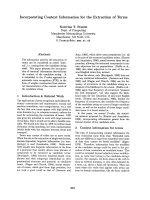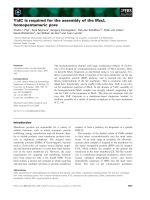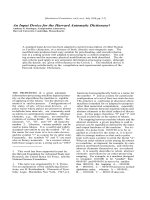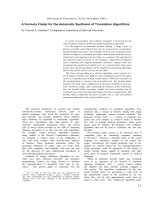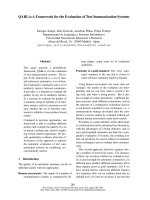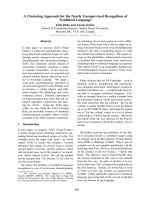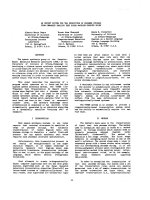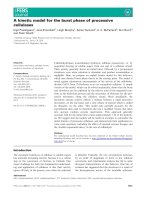Báo cáo khoa học: "Gas-permeable ethylene bags for the small scale cultivation of highly pathogenic avian influenza H5N1 and other viruses in embryonated chicken eggs" docx
Bạn đang xem bản rút gọn của tài liệu. Xem và tải ngay bản đầy đủ của tài liệu tại đây (389.51 KB, 7 trang )
METH O D O LOG Y Open Access
Gas-permeable ethylene bags for the small scale
cultivation of highly pathogenic avian influenza
H5N1 and other viruses in embryonated chicken
eggs
Sara B Hamilton
1
, Deirdre E Daniels
1
, William A Sosna
1
, Eric R Jeppesen
2
, Julie M Owells
1
, Micah D Halpern
1
,
Kimberly S McCurdy
1
, Jonathan O Rayner
1
, John A Lednicky
1*
Abstract
Background: Embryonated chicken eggs (ECE) are sometimes used for the primary isolation or passage of
influenza viruses, other viruses, and certain bacteria. For small-scale experiments with pathogens that must be
studied in biosafety level three (BSL3) facilities, inoculated ECE are sometimes manipulated and maintained in small
egg incubators within a biosafety cabinet (BSC). To simplify the clean up and decontamination of an egg incubator
in case of egg breakage, we explored whether ethylene breather bags could be used to encase ECE inoculated
with pathogens. This concept was tested by determining embryo survival and examining virus yields in bagged
ECE.
Results: Virus yields acceptable for many applications were attained when influenza-, alpha-, flavi-, canine
distemper-, and mousepox viruses were propagated in ECE sealed within ethylene breather bags.
Conclusions: For many small-scale applications, ethylene breather bags can be used to encase ECE inoculated
with various viruses.
Background
Embryonated (embryonating) chicken eggs (ECE) have
long been used for isolating or propagating influenza
and other viruses and certain bacteria such as Rickettsia
[1-5] . Alpha-, corona-, flavi-, paramyxo-, and poxviruses
are among the non-influenza viruses sometimes grown
in ECE. For small-scale work with pathogens that must
be worked with in BSL3 facilities, inoculated ECE are
someti mes housed in small egg incubators kept within a
BSC [such a practice is not practical for medium-to-
large diagnostic operations, wherein ECE are placed in
incubators within a bioBubble (Ft. Collins, CO) or simi-
lar barrier and containment enclosure]. Since ECE are
fragile, accidental egg br eakage is possible. Furthermore,
diagnostic specimens inoculated into ECE may contain
contaminating flora that form enough gas to break the
egg shell. We sought a simple method to contain spil-
lage from a broken ECE inoculated with dangerous
pathogens , and explored the feasibility of using ethylene
breather bags for that purpose. Ethylene breather bags
are permeable to oxygen and carbon dioxide but retain
water, and are used in the aquarium industry to trans-
port live fish. Chicken embryo survival was examined
and the yield of various influenza and other viruses in
bagged eggs was determined.
Results
1. Embryo survival
No differences were detected in the survival of chicken
embryos in bagged vs non-bagged 7 - 12 day old ECE
after five days of incubation without rotation as per-
formed for virus-inocu lated ECE. Noteworthy, especially
during summer months, up to 20% attrition (death of
non-inoculated ECE) occurred with some batches,
regardless of whether the ECE w ere b agged or not
bagged. Since the ECE are checked and culled if dead
* Correspondence:
1
Energy and Life Sciences Division, Midwest Research Institute, 425 Volker
Boulevard, Kansas City, Missouri, 64110, USA
Hamilton et al. Virology Journal 2010, 7:23
/>© 2010 Hamilton et al; licensee BioMed Central Ltd. This is an Open Access article distributed under the terms of the Creative
Commons Attribution License ( es/by/2. 0), whi ch permits unrestrict ed use, distribution, and
reproduction in any medium, provided the origi nal work is properly c ited.
upon receipt from the supplier and again immediately
prior to use, the deaths have been attributed to failure
to thrive under normal circumstances. Since the ECE
are not rotated, a factor contributing to attrition may be
attachment of the embryo to the egg-shell and its subse-
quent deleterious deformation/improper development.
2. Propagation of Influenza viruses in bagged ECE
Various type A and B influenza viruses were grown to
levels acceptable for our applications in ECE in ethylene
breather bags. It was not nec essary to add water to
humi dify the interiors of sealed bags. Compared to bags
containing eggs without extraneously added moisture,
virus yields and embryo developm ent were similar when
up to one ml of sterile water or a moistened filter were
placed with eggs in bags (data not shown). Virus growth
occurred regardless of the inoculation route/site and
storage orientation (prone or horizontal) of the egg
(data not shown). An example of a virus-inoculated egg
in a breather bag is shown in Figure 1. C omparisons of
virus titers calculated as 50% tissue culture infectious
dose (TCID
50
) in Madin-Darby canine kidney (MDCK)
cells and 50% egg infectious dose (EID
50
) in ECE of two
influenza viruses strains grown in the chorioallantoic sac
(CAS) of ECE (incubated prone, with air sac atop) are
given in Table 1. Representative titers (TCID
50/
ml)
obtained for various other influenza A and B viruses are
giveninTables2,3,4,5,6,and7.Aspreviously
observed, some recent influenza virus H3N2 isolates
from humans, such as A/Brisbane/10/2007 (H3N2)
[Table 3] produced low virus titers during primary pas-
sage in ECE [6,7].
3. Canine distemper virus
Egg-adapted Canine distemper virus (CDV) strain
Lederl e (Ameri can-1 lineage) obtaine d from the Ameri-
can Type Culture Collection (ATCC, Manassas, VA)
grew readily in b agged ECE, evidenced by RT-PCR
detection of CDV RNA i n isolated chorioallantoic mem-
brane (CAM) five days post-infection (p.i.). Changes in
the general appearance (of the CAM) were also vi sible
without staining and microsco pic evaluation o f isolated
CAM. In contrast, wild-type CDVs from canine speci-
mens required two to three serial passages before facile
detection (by RT-PCR or visually apparent changes in
the appearance of the CAM). Titers of 10
6
-10
7
pfu/ml
were obtained from isolated CAM with CDV-Lederle
upon first passage with a starting inoculum of 10
2
pfu/
ECE in both bagged and non-bagged ECE, whereas 1 0
1
-10
2
pfu/ml were obtained with wild-type American-2
lineage CDVs (titer of CDV in initial inoculum
unknown) in bagged and non-bagged ECE. Similarly,
after three serial passages of wild-type CDVs with a
starting inoculum of 10
2
pfu/ECE in either bagged or
non-bagged ECE, the yields of cell-associated virus
(CAM-associated virus) were around 10
3
pfu/ml, and
were not detectable to 10
1
pfu/ml for CDV isolates in
allantoic fluid (details to be presented elsewhere).
4. Mousepox virus strain Moscow
“Pocks” were visible on the CAM of bagged ECE at 3
days post-infection (data not shown).
5. Venezuelan equine encephalitis virus strain Trinidad
donkey ((VEEV-Td)
Chicken embryos were usually killed (by the virus)
within 24 hrs after infection with 10
3
pfu of VEEV-Td
per ECE . Virus yi elds in b agged ECE were: CAM >
brain (head) > body > allantoic fluid > yolk sac (YS)
membrane. Virus yields from homogenized CAM were
gen erally around 3 × 10
8
pfu/mL whereas homogenized
brain tissue yielded about 4 × 10
7
pfu/mL as measured
by plaque assays in African green monkey kidney (Vero)
cells. Though a direct comparison with VEEV-Td grown
Table 1 Yields Obtained for Influenza Virus Grown in
Bagged
a
vs Non-bagged ECE
a
.
Bagged ECE Non-bagged ECE
Virus Strain TCID
50
b
EID
c
TCID
50
EID
A/NWS/1933 (H1N1) 8.05 ± 0.15 9.25 ± 0.25 8.1 ± 1.0 9.4 ± 0.2
A/HK/8/1968 (H3N2) 7.95 ± 0.05 9.3 ± 1.0 7.75 ± 0.25 9.0 ± 0.2
a
CAS fluids from four ECE were harvested and pooled 48 hrs after infection of
9-day old EC E with 10
2
TCID
50
units of vir us and incubation at 34°C. The
experiment was repeated three separate times.
b
Log
10
of TCID
50
/ml in MDCK
cells in serum-free growth medium plus trypsin.
c
Log
10
of EID
50
/ml obtained
in non-bagged 10-day-old ECE incubated at 34°C.
Table 2 Yields Obtained for Influenza virus H1N1 Strains
Grown in Bagged ECE.
Strain Specimen source Log
10
TCID
50
/ml
a
A/Puerto Rico/8/1934 Human 7.5
A/New Caledonia/20/1999 Human 7.9
A/Hawaii/15/2001 Human 7.9
A/Solomon Islands/03/2006 Human 7.0
A/New York/18/2009 Human 8.0
A/Mexico/408/2009 Human 7.0
a
TCID
50
/ml of CAS fluids in MDCK cells in serum-free growth medium plus
trypsin. CAS fluids from four ECE were harvested and pooled 48 hrs after
infection of 9-day old ECE with 10
2
TCID
50
units of virus and incubation at 34°C
Table 3 Yields Obtained for Influenza virus H3N2 Strains
Grown in Bagged ECE.
Strain Specimen source Log
10
TCID
50
/ml
a
A/New York/55/2004 Human 7.9
A/Wisconsin/67/2005 Human 8.0
A/Hiroshima/52/2005 Human 6.9
A/Brisbane/10/2007 Human 5.0
a
TCID
50
/ml of CAS fluids in MDCK cells in serum-free growth medium plus
trypsin. CAS fluids from four ECE were harvested and pooled 48 hrs after
infection of 9-day old ECE with 10
2
to 10
3
TCID
50
units of virus and incubation
at 34°C.
Hamilton et al. Virology Journal 2010, 7:23
/>Page 2 of 7
in non-bagged ECE was not allowed due to biosafety
rules imposed by our institute, the virus yields from the
CAM are within the expectedrangeforalphaviruses
grown in ECE based on historic data [8].
6. Japanese encephalitis virus strain Nakayama (JEV-Nak)
Chicken embryos usually died between 48 - 72 hrs after
infection with 10
3
pfu of JEV-Nak per ECE. Virus yields
in bagged ECE were: brain (head) > body > allantoic
fluid > CAM > YS membrane. Virus yields from homo-
genized brain tissue were generally around 4 × 10
5
pfu/
mL whereas homogenized body tissue yielded about 4 ×
10
4
pfu/mL by plaque assay in Vero cells. A direct com-
parisonofourstockofJEV-Nakgrowninnon-bagged
ECE was not allowed due to biosafety rules imposed by
our institute.
Discussion
Various viruses were successfully cultivated in ECE in
ethylene breather bags. No defective bags (defined as
bags with obvious holes) were observed during this
work. Whereas additional safety is inferred since the
gas-permeable ethylene bags retain water (and thus
much larger virus particles should also be retained), this
has not been extensively tested at MRI. However, a pre-
liminary test supports this thesis: T4 phage inside intact
bags did not infect E. coli when the bags were immersed
in flasks conta ining the bacteria for 24 hrs (starting out
with log-phase bacteria). In contrast, the phage infected
E. coli when pin-holes were made in the bags prior to
immersion in flasks containing log-phase bacterial
cultures. Though exhaustive tests were not performed,
chicken embryos past seven days of development did
not thrive in various other types of plastic bags.
Influenza virus yields in bagged ECE were consistent
with expectations; for example, titers within the range of
10
6
to 10
9
pfu/ml (infectivity measured in MDCK cells)
are common for primary or low-passage virus isolates
provided contaminating microbial flora normally present
in clinical specimens are suppressed by antibiotic treat-
ment. The variability in virus yield is a lso dependent on
viral strain. The growth and yield of other viruses (CDV,
Mousepox virus,JEV-Nak,andVEEV-Td)inbagged
ECE was also consistent with expectations. Whereas
some JEV strains that have been adapted for growth in
ECE attain higher viral yields than was attained here, it
isnotconsideredaberranttoattaintheloweryields
with fresh or low-passage JEVstocks.Similarly,wild
type CDVs may require adaptation and serial passage in
ECE before vigorous growth is detected [9,10], as
observed here.
For small-scale operations using relatively few ECE for
the propagation of BSL3 pathogens, breather bags are
convenient for containing spillage from broken eggs.
Use of the bags for the applicati on described here offers
one solution over the need to purchase or construct
additional barrier and containment enclosures. There
are two drawbacks: bagging ECE imposes additional
labour constraints, and candling of the eggs through the
bags can be challenging especially when numerous eggs
are present in a bag. However, this technique is only
intended for small-scale experiments requiring few ECE.
The same idea may be useful for tissue culture plate sys-
tems since they have the same problem if dropped; i.e.
as an added safety feature.
For larger-scale needs, other primary containment
devices could achieve the same goal of increased con-
tainment such as tradition egg incubators placed inside
a primary containment device such a BSC or high-effi-
ciency particulate arrestor (HEPA) - filtered vinyl enclo-
sures.Onealternativewouldbetheuseofanegg
incubator with removable self-sealing modular contain-
ers for eggs. A large stand alone incubator could thus
be positioned somewhere outside the BSC, and inocu-
lated ECE safely transported in and out of the BSC and
the containers with ECE repositioned into designated
racks in the incubator. Midwest Research Institute is
currently building such a device.
Conclusions
For small-scale o perations, ethylene breather bags can
be used to enclose ECE infected with influenza viruses,
CDV, Mousepox virus, JEV-Nak, and VEEV-Td as a pre-
caution to contain possible spillage from broken eggs.
We predict these bags will work for ECE infected with
Table 4 Yields Obtained for Miscellaneous Influenza virus
Type A Strains Grown in Bagged ECE
Strain Specimen source Log
10
TCID
50
/ml
a
A/Alberta/79/2003 (H2N3) Mallard 6.0
A/Wisconsin/1968 (H5N9) Turkey 7.9
A/New York/107/2003 (H7N2) Human 5.6
A/Netherlands/219/2003 (H7N7) Human 9.7
A/Hong Kong/G9/1997 (H9N2) Chicken 8.2
a
TCID
50
/ml of CAS fluids in MDCK cells in serum-free growth medium plus
trypsin. CAS fluids from four ECE were harvested and pooled 48 hrs after
infection of 9-day old ECE with 10
2
to 10
3
TCID
50
units of virus and incubation
at 34°C.
Table 5 Yields Obtained with H5N1 Reverse Genetics
Constructs in an A/PR/8/1934 Vaccine Strain Background
Grown in Bagged ECE.
Strain Log
10
TCID
50
/ml
a
A/Anhui/01/2005 (H5N1)-PR8-IBCDC-RG 8.7
A/VNH5N1-PR8/CDC-RG 10.0
a
TCID
50
/ml of CAS fluids in MDCK cells in serum-free growth medium plus
trypsin. CAS fluids were pooled from four ECE and harvested 48 - 72 hrs after
infection of 9-day old ECE with 10
2
to 10
3
TCID
50
units of virus and incubation
at 34°C.
Hamilton et al. Virology Journal 2010, 7:23
/>Page 3 of 7
other viruses as well, and may be useful for tissue cul-
ture plate systems as well. Intended for small scale pro-
jects, the procedure is not practical for medium- to
large-scale operations.
Methods
1. Breather bags
Ethylene breather bags were obtained from Kordon LLC
(Hayword, CA). For up to three ECE, 5.5 × 8 inch bags
were used, whereas 7.5 × 12 inch bags were used for
small-batch cultivatio n of up to six ECE inoculated with
virus.
2. Embryonated chicken eggs
Specific pathogen-free (SPF) Chicken anemia virus
(CAV)-free ECE were obtained from Charles River
Laboratories (Wilmington, MA).
3. Influenza virus propagation in embryonated chicken
eggs
Various methods for the growth of influenza viruses in
ECE were tested. The primary method was by inocula-
tion of the CAS. Amniotic sac (AS) inoculation (solely
or in combination with CAS inoculation), YS, and CAM
routes of inoculation were also tested for some virus
strains. Inoculation into the AS is technically demanding
and primarily reserved for isolating influenza viruses
from humans when standard methods are shown to be
insuf ficient or for high-priority efforts. Inoculations into
the YS and CAM are performed for the primary isola-
tion of some avian influenza viruses from non-chicken
species and some swine influenza viruses [[11], and J.
Lednicky, unpublished observations]. For CAS, AS, and
CAM inoculations, 9 to 11 day-old ECE were used (for
AS inoculations, ECE up to 14 days old were also
tested). ECE that were 7 - 9 days-old were used for YS
inoculation. For CAS and top-side AS inoculations, the
embryo was located by candling, the egg-top decontami-
nat ed with alcohol, and a hole punched over the air sac
without piercing the CAM. The ECE were inoc ulated
with up to 100 μl of virus-containing material using a 1
ml tuberculin syringe and 22-gauge, 1.5-inch (~4 cm)
needle, the hole sealed with laboratory tape, and the egg
incubated at 34°C for most influenza A or B strains, and
at 37°C for H5N1 strains. During inoculation, efforts are
made to avoid damage of the CAM, which can result in
hemorrhage that leads to death of the embryo.
Top- side inoculation of the AS was performed by: (a)
direct inoculation while candling to guide the needle
beside the embryo, or (b) by sending the needle through
the natural air sac until the needle touched the embryo;
upon contact with the embryo, the needle’s opening was
in the AS. Sideway inoculation of the AS was also evalu-
ated after first creating a false air-space beside the
embryo. Similar manipulations were used for YS and
CAM inoculations. The incubation period varied accord-
ing to virus type and strain; in general, up to 24 hrs
were used for highly pathogenic H5N1 viruses, 48 - 72
hrs (or longer) for seasonal and type B influenza viruses.
Post-inoculation, the eggs were placed in ethylene
bags, the top part of the bag rolled over individual or
multiple eggs, and the rolled plastic secured using a
Table 6 Yields Obtained with Influenza virus H5N1Strains Grown in Bagged ECE.
Strain Specimen source Log
10
TCID
50
/ml
a
A/Hong Kong/220/97 Chicken 9.0
A/Hong Kong/156/97 Human 9.4
A/Hunan/795/2002 Duck 9.0
A/Yunnan/1251/2003 Chicken 7.0
A/Vietnam/1203/2004 Human 8.3
A/Mongolia/244/2005 Whooper Swan 8.0
A/Iraq/207-NAMRU3/2006 Human 10.0
A/Hong Kong/45/2006 Scaly Breasted Munia 8.0
A/Hong Kong/645/2006 Common Magpie 10.0
A/Hong Kong/1038/2006 Japanese White Eye 10.0
A/Hong Kong/D-06-0947/2006 Chicken 8.0
A/Korea/IS/2006 Chicken 9.0
a
TCID
50
/ml of CAS fluids in MDCK cells in serum-free growth medium plus trypsin. CAS fluids were pooled from four ECE and harvested 48 - 72 hrs after infection
of 9-day old ECE with 10
2
to 10
3
TCID
50
units of vir us and incubation at 37°C.
Table 7 Yields Obtained for Influenza virus B Strains
Grown in Bagged ECE.
Strain Log
10
TCID
50
/ml
a
B/Ohio/01/2005 (Victoria/2/87-like) 9.0
B/Florida/07/2004 (Yamagata/16/88-like) 8.0
B/Malaysia/2506/2004 7.0
B/Florida/04/2006 7.1
a
TCID
50
/ml of CAS fluids in MDCK cells in serum-free growth medium plus
trypsin. CAS fluids were pooled from four ECE and harvested 72 hrs after
infection of 9-day old ECE with 10
2
to 10
3
TCID
50
units of virus and incubation
at 34°C.
Hamilton et al. Virology Journal 2010, 7:23
/>Page 4 of 7
rubber band, paper clamp, or laboratory tape. Attempts
were made to collect virus just before death of the
embryo. Prior to harvest, the e ggs were refrigerated for
up to 18 hrs to kill the embryo and constrict the blood
vessels (and thus reduce bleeding into the AS during
harvest). Virus was then harvested as appropriate to the
inoculation site and aliquots of the virus stored at -80°C
for up to one year or in liquid nitrogen for long-term
(>one year) storage. Influenza virus genomic sequences
were analyzed by isolating viral RNAs from allantoic
fluid (QIAamp Viral RNA kit; QIAGEN, Valencia, CA)
and performing two-step reverse transcription-PCR with
synthetic universal and other oligonucleotide primers
[12,13]. The sequences were determined using an
Applied Biosystem 3130 DNA analyzer, BigDye Termi-
nator (v. 3.1) chemistry, and the same oligonucleotide
primers used for RT-PCR. Specific details on the
Figure 1 Virus-inoculated ECE enclosed in an ethylene breather bag. The embryo’s position prior to inoculation of the ECE with virus was
marked with the letter “X”.
Hamilton et al. Virology Journal 2010, 7:23
/>Page 5 of 7
primers used for influenza A an d B viruses are available
upon request.
4. Canine distemper virus isolation and propagation of
egg-adapted CDV strains in ECE
Egg-adapted CDV-Lederle was purchased from the
ATCC. Six to eight day old ECE were used, with inocu-
lation to the CAM. The inoculated eggs were observed
daily to monitor embryo viability, and chilled to 4°C
after 5 days’ incubation and the CAMs harvested and
homogenized to a 10% w/v suspension in phosphate-
buffered saline with 0.5% w/v purified BSA fraction V.
The homogenate was clarified with a low speed spin for
10 min at 4°C, and the supernatant used either as an
inoculum for the succeeding passage or stored at -80°C.
Wild-type CDVs were isolated f rom lung and/or brain
homogenates of dogs with distemper (data to be pre-
sented elsewhere). CDV isolates were analyzed by RT-
PCR and nucleotide sequence analyses as previously
described [14,15], and viral titers calculated as plaque
forming units/ml in Vero cells expressing engineered
canine signalling lymphocyte activating molecule
(cSLAM) 5 days p.i. (details to be presented elsewhere).
5. Mousepox virus propagation in ECE
Suspensions of Mousepox virus in PBS (0.1 - 0.5 ml)
were inoculated onto the CAM of 10 - 12 day old ECE.
The ECE were incubated for 3 days at 37°C; virus
growth was evidenced by the presence of “pocks” on the
CAM [16]. Viral titers (TCID
50
) were determined in
BSC-1 cells.
6. VEEV propagation in ECE
VEEV was inoculated into the YS of 6 - 8 day old ECE,
and incubated at 35 -37°C for up to 24 hrs. The propa-
gated virus was analyzed by pl aque assay and full-geno-
mic sequencing (details to be presented elsewhere).
7. JEV propagation in ECE
JEV was inoculated into the YS of 8 - 9 day old ECE,
and incubated at 3 5 -37°C for 48 - 72 hrs. The propa-
gated virus was analyzed by pl aque assay and full-geno-
mic sequencing (details to be presented elsewhere).
8. Tissue culture cells
MDCK and Vero cell lines were obtained from the
ATCC, or from Diagnostic Hybrids, Inc. (Athens, OH).
The cells were propagated in Dulbecco’ sModified
Eagle’s Medium (DMEM) supplemented with L-Alanyl-
L-Glutamine (GlutaMAX™ ,InvitrogenCorp.,Carlsbad,
CA), antibiotics [PSN: penicillin, streptomycin, neomy-
cin (Invitrogen Corp.], bicarbonate, and gamma-irra-
diated heat inactivated fetal bovine serum (HyClone,
Thermo Fisher Scientific, Inc., Pittsburgh, PA). The
MDCK and Vero cells tested negative for mycoplasma
DNA using a Takara PCR Mycoplasma Detection kit
(Takara Bio, USA, Thermo Fisher).
9. Biocontainment facilities and additional safety
precautions
In-vitro experiments with H5N1 viruses, JEV, and VEEV,
and their cultivation in ECE were conducted in an
USDA-approved BSL3-enhanced (BSL3+) containment
facility.
10. Propagation of Influenza viruses in MDCK cells
Viruses were grown in MDCK cells in serum-free
DMEM media supplemented with bicarbonate, antibio-
tics, and 1.0 μg/mL L-1-tosylamido-2-phenylethyl chlor-
omethyl ketone (TPCK)- treated, mycoplasma- and
extraneous virus-free trypsin (Worthington Biochemical
Company, Lakewood, NJ) at 34 - 37°C (as appropriate
for each virus strain) in 5% CO
2
.
11. Determination of TCID
50
values
TCID
50
values were calcul ated for influenza viruses and
Mousepox virus by the Reed-Muench method [17]. For
these determinations, influenza viruses were incubated
for 5 days in MDCK, and Mousepox virus for 4 days in
BSC-1 cells.
12. Plaque assays
Standard plaque assays using agarose overlays were used
to determine JEV and VEEV titers in Vero cells [18].
Acknowledgements
The technical assistance of Cheryl J Nevins, Sandra J Lawrence, and Jane M
Morrissey is greatly appreciated.
Author details
1
Energy and Life Sciences Division, Midwest Research Institute, 425 Volker
Boulevard, Kansas City, Missouri, 64110, USA.
2
Biosafety/Biosurety Office,
Midwest Research Institute, 425 Volker Boulevard, Kansas City, Missouri,
64110, USA.
Authors’ contributions
SBH grew influenza viruses, JEV, and VEEV, interpreted data, helped train
technicians, and helped draft the manuscript; DED grew influenza viruses,
interpreted data, oversaw the training of technicians, and managed the
influenza virus programs; WAS grew JEV, VEEV, and influenza viruses, and
interpreted data; ERJ is the MRI biosafety officer and recommended
evaluation of methodologies that might reduce biohazards stemming from
broken virus-inoculated ECE; JMO grew JEV and VEEV; KSM grew JEV and
VEEV and managed alpha- and flavivirus programs; MDH performed
molecular genetic studies including sequence analyses and alignments; JOR
performed JEV and VEEV studies; JAL conceived of using ethylene breather
bags for this application, isolated CDV, participated in molecular genetic
studies and sequence analyses, interpreted data, oversaw the training of
technicians, and drafted the manuscript. All authors read and approved the
final manuscript.
Competing interests
The authors declare that they have no competing interests.
Received: 8 January 2010
Accepted: 28 January 2010 Published: 28 January 2010
References
1. Woodruff AM, Goodpasture EW: The susceptibility of the chorio-allantoic
membrane of chick embryos to infection with the fowl-pox virus. Am J
Path 1931, 7:209-222.5.
2. Burnet F: Influenza virus infections of the chick embryo by the amniotic
route. Aust J Exp Biol Med Sci 1940, 18:353-360.
Hamilton et al. Virology Journal 2010, 7:23
/>Page 6 of 7
3. Burnet FM: Growth of influenza virus in the allantoic cavity of the chick
embryo. Aust J Exp Biol Med Sci 1941, 19:291-295.
4. Henle W, Henle G, Stokes JJ: Demonstration of the efficacy of vaccination
against influenza type A by experimental infection of human beings. J
Immunol 1943, 46:163-175.
5. Beveridge WIB, Burnet FM: The cultivation of viruses and rickettsiae in the
chick embryo. Med Res Council 1946, Special Report No. 256.
6. Lu B, Zhou H, Ye D, Kemble G, Jin H: Single amino acid substitutions in
the hemagglutinin of influenza A/Singapore/21/04 (H3N2) increase virus
growth in embryonated chicken eggs. Vaccine 2006, 24 :44-46.
7. Lu B, Zhou H, Chan W, Kemble G, Jin H: Improvement of Influenza A/
Fujian/411/02 (H3N2) virus growth in embryonated chicken eggs by
balancing the hemagglutinin and neuraminidase activities using reverse
genetics. J Virol 2005, 79:6763-6771.
8. Bang FB: The course of experimental infection of the chick embryo with
the virus of equine encephalomyelitis. J Exp Med 1943, 77:337-344.
9. Appel MJG, Gillespie JH: Canine distemper virus. Virol Monog 1972, 11:1-96.
10. Schönbauer M, Kölbl S, Schönbauer-Längle A: Perinatale staupeinfektion
bei drei eisebären (Ursus maritimus) und bei einem brillenbären
(Tremarctos ornatus). Verh Int Symp Erkrank Zoot 1984, 26:131-136.
11. Woolcock PR, McFarland MD, Lai S, Chin RP: Enhanced recovery of avian
influenza viruses by a combination of chicken embryo inoculation
methods. Avian Dis 45:1030-1035.
12. World Health Organization: Manual on Animal Influenza Diagnosis and
Surveillance />WHO_manual_on_animal-diagnosis_and_surveillance_2002_5.pdf.
13. Hoffmann E, Stech J, Guan Y, Webster RG, Perez DR: Universal primer set
for the full-length amplification of all influenza A viruses. Arch Virol 2001,
146:2275-2289.
14. Lednicky JA, Dubach J, Kinsel MJ, Meehan TP, Bocchetta M, Hungerford LL,
Sarich NA, Witecki KE, Braid MD, Pedrak C, Houde CM: Genetically distant
American Canine distemper virus lineages have recently caused
epizootics with somewhat different characteristics in raccoons living
around a large suburban zoo in the USA. Virol J 2004, 1:e2.
15. Lednicky JA, Meehan TP, Kinsel MJ, Dubach J, Hungerford LL, Sarich NA,
Witecki KE, Braid MD, Pedrak C, Houde CM: Effective primary isolation of
wild-type canine distemper virus in MDCK, MV1 Lu and Vero cells
without nucleotide sequence changes within the entire haemagglutinin
protein gene and in subgenomic sections of the fusion and phospho
protein genes. J Virol Methods 2004, 118:147-157.
16. Fenner F: Mousepox.
The mouse in biomedical research Academic
PressFoster H, Small JD, Fox JG 1982, II:209-230.
17. Reed LJ, Muench H: A simple method for estimating fifty percent
endpoints. Am J Hyg 1938, 27:493-497.
18. Powers AM, Brault AC, Shirako Y, Strauss EG, Kang W, Strauss JH, Weaver SC:
Evolutionary relationships and systematics of the alphaviruses. J Virol
2001, 75:10118-10131.
19. Chi XS, Hu A, Bolar Al-Rimawi W, Zhao P, Tam JS, Rappaport R, Cheng SM:
Detection and Characterization of New Influenza B Virus Variants in
2002. J Clin Microbiol 2005, 43:2345-2349.
doi:10.1186/1743-422X-7-23
Cite this article as: Hamilton et al.: Gas-permeable ethylene bags for the
small scale cultivation of highly pathogenic avian influenza H5N1 and
other viruses in embryonated chicken eggs. Virology Journal 2010 7:23.
Submit your next manuscript to BioMed Central
and take full advantage of:
• Convenient online submission
• Thorough peer review
• No space constraints or color figure charges
• Immediate publication on acceptance
• Inclusion in PubMed, CAS, Scopus and Google Scholar
• Research which is freely available for redistribution
Submit your manuscript at
www.biomedcentral.com/submit
Hamilton et al. Virology Journal 2010, 7:23
/>Page 7 of 7
